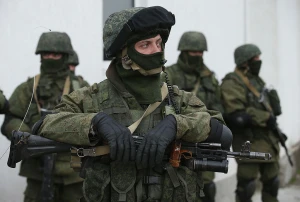
Wagner's actions create new hybrid threat in Europe - military expert Zgurets
Serhiy Zgurets, Defense Express CEO, noted that Wagner PMC mercenaries on the border of Belarus with NATO countries may be trying to create a zone of uncertainty
He expressed this opinion on Espreso TV.
"Wagner's actions are potentially creating a new hybrid threat in Europe. Such a threat may be on the verge of making it impossible for NATO countries to act in a consolidated manner if Wagner's group is active, and creating a certain zone of uncertainty. Because, relatively speaking, how can we determine who owns the Wagner members, who seem to have no reason to be associated with the Russian Ministry of Defense or with the Belarusians, with whom they have not signed anything either? That is, Wagner PMC is simply a criminal group. Is it possible to fire missiles at Moscow for this if, for example, the Wagner mercenaries seize the Suwalki corridor? There seems to be no legal basis for this," the military expert commented.
Serhiy Zgurets noted that with such hybrid approaches, the Russians will now try to undermine the situation by using Wagner members.
How the Wagner soldiers ended up in Belarus
After the mutiny of Wagner PMC leader Yevgeny Prigozhin in late June, the Kremlin announced the relocation of Wagner mercenaries to Belarus.
On June 27, self-proclaimed President of Belarus Alexander Lukashenko confirmed the arrival of Yevgeny Prigozhin in the country. According to him, Wagner mercenaries who arrived with him will not guard the Russian tactical nuclear weapons deployed there. However, Lukashenko emphasized that he expects the mercenaries to help in the defense of Belarus, without specifying the potential source of the country's perceived threat.
On June 29, a satellite recorded the construction of a tent camp near Asipovichy in the Mogilev region of Belarus, and on July 3, Russian media published a photo of an alleged Wagner camp.
On July 11, the Belarusian Ministry of Defense stated that the Wagner mercenaries would train the Belarusian army.
On July 14, media reported that training sessions with units of the territorial troops were taking place near Asipovichy (Belarus), where Wagner PMC fighters were acting as instructors in some military disciplines.
On the morning of July 15, a large convoy of cars and trucks with license plates of the so-called DPR and LPR was spotted in Belarus. Ukraine’s State Border Guard Service confirmed that those were mercenaries of the Wagner PMC.
On Sunday, July 16, the Belarusian Hajun monitoring group reported that two flags - of Russia and the Wagner PMC - had been installed at the checkpoint on the border between Belarus and Russia. Wagner Group announced that on July 30, their main base in the Russian Federation, located in the village of Molkino in Krasnodar Krai, would be closed.
On July 19, Wagner PMC financier Yevgeny Prigozhin addressed Wagner fighters in Belarus, calling the situation at the front a "disgrace" and urging mercenaries to "wait for the moment to show their full potential."
Later, on July 23, self-appointed President of Belarus Alexander Lukashenko announced the desire of the mercenaries from the Russian Wagner PMC to "go on an excursion" to Poland. The same day, it was reported that the tenth column of Wagner's mercenaries, which included at least ten pieces of equipment, had arrived in Belarus.
On July 27, the National Resistance Center reported that Wagner PMC units were looking for people in Belarus who were ready to fight against Lithuania and Poland. Also the same day Belarusian Hajun monitoring group reported that the twelfth column of Wagner's PMC, which included at least 50 pieces of equipment, had arrived in Belarus.
On July 28, 13th convoy of mercenaries with at least 80 vehicles arrived in Belarus.
On July 29, Polish Prime Minister Mateusz Morawiecki announced that more than 100 Wagner members had gone to the Suwalki corridor.
- News













































